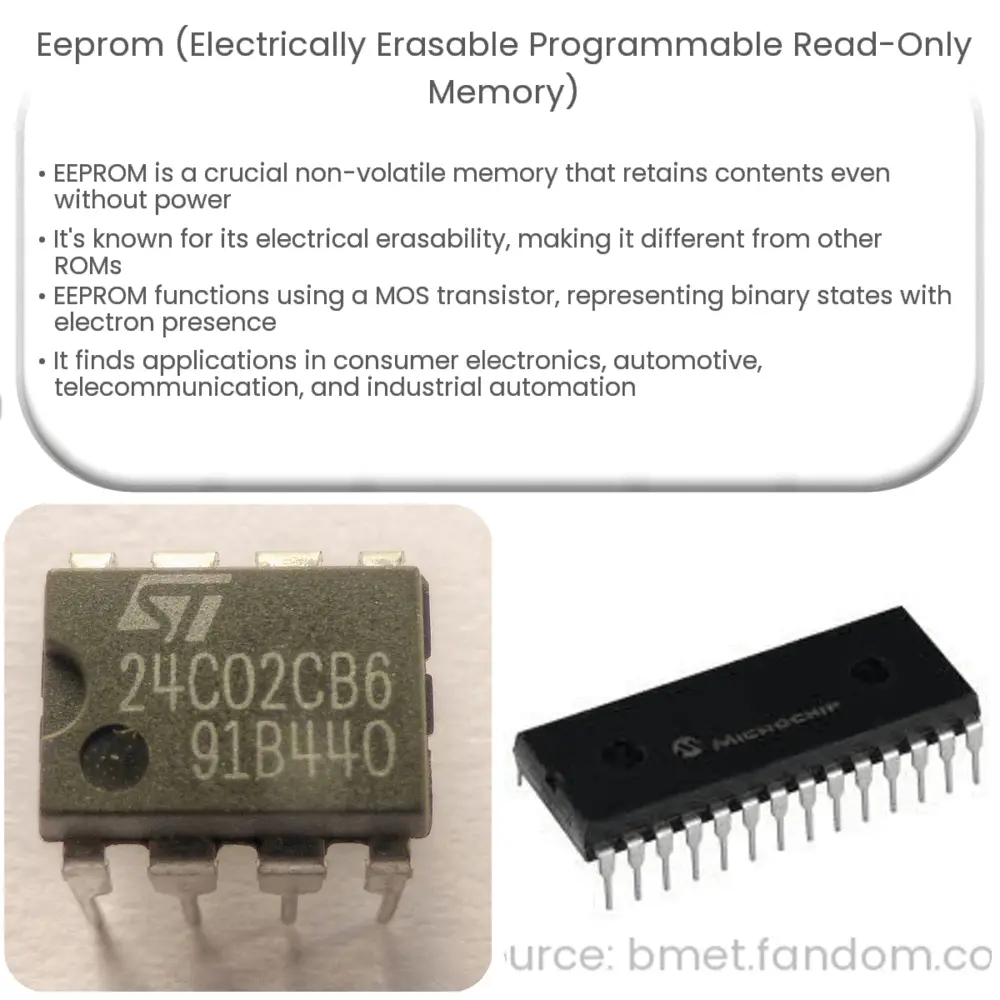Explore the world of EEPROM (Electrically Erasable Programmable Read-Only Memory), its features, applications, and role in modern electronics.

Introduction to EEPROM
EPROM, or Electrically Erasable Programmable Read-Only Memory, is a type of non-volatile memory that retains its contents even when power is turned off or disconnected. It is a crucial technology in modern electronics, playing a significant role in the operation of a wide range of devices.
Features of EEPROM
- Non-Volatile Memory: As a type of non-volatile memory, EEPROM retains information even after the system’s power is shut down. This makes it ideal for storing important or infrequently changed data.
- Electrical Erasability: EEPROM is named for its electrical erasability feature. This differentiates it from other forms of ROM, which require a more complex and time-consuming erasure process.
- Endurance: EEPROM can be erased and reprogrammed a specific number of times. The endurance of an EEPROM is the number of times it can undergo this cycle before the cells start to fail.
Working of EEPROM
The functioning of EEPROM hinges on the characteristic of a MOS or Metal-Oxide-Semiconductor transistor. It utilizes a floating gate, which can hold or store electrons. The presence or absence of these electrons can be used to represent the binary states of 1 and 0.
During the writing process, a high voltage is applied to the control gate. This causes the electrons to get attracted to the floating gate, thereby trapping them. This state signifies a “0”. To erase or revert this to “1”, a high voltage is applied in a manner that causes the electrons to be repelled from the floating gate.
Applications of EEPROM
EEPROM is a versatile technology that finds its application in various sectors. A few of these include:
- Consumer Electronics: EEPROMs are used in a wide range of consumer electronics like television sets, radios, and computers where they store settings and calibration data.
- Automotive: In the automotive sector, EEPROMs are used in engine control units to store data that controls the functioning of the engine.
Applications of EEPROM (Continued)
- Telecommunication: In telecommunication devices, EEPROMs are used to store phone numbers and call logs, among other data.
- Industrial Automation: EEPROMs are extensively used in industrial automation settings where they are used to store firmware or configuration parameters of the automation systems.
Advantages and Limitations of EEPROM
- Advantages: EEPROM’s primary advantages include its non-volatility and the ability to erase and reprogram individual bytes of data at a time, which is not possible with EPROM. Additionally, its ability to maintain data without continuous power makes it an ideal choice for storing configuration and calibration data in various devices.
- Limitations: The primary limitation of EEPROMs is their limited endurance. After a certain number of write/erase cycles (typically in the millions), the memory cells begin to wear out. Also, the writing and erasing processes of EEPROMs are slower compared to other types of memories like RAM.
EEPROM versus Other Types of Memory
EEPROM differs from other types of memory such as RAM, Flash memory, and EPROM. Unlike RAM, EEPROM is non-volatile. Compared to Flash memory, EEPROM can erase and write data at the byte level, whereas Flash memory does this at the block level, making EEPROM more flexible. In contrast to EPROM, EEPROM can be erased electrically and does not require exposure to ultraviolet light, making the erasure and reprogramming process faster and less cumbersome.
Conclusion
In conclusion, EEPROM is a crucial type of non-volatile memory used widely across various sectors for its ability to retain data without continuous power and its feature of electrical erasability. Despite its limitations such as limited endurance and slower writing and erasing processes compared to other types of memories, the versatility and convenience offered by EEPROMs make them indispensable in the realm of modern electronics.

